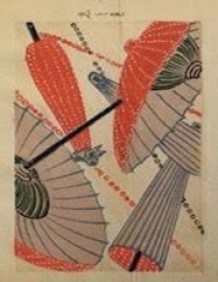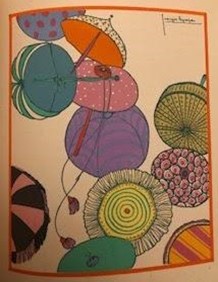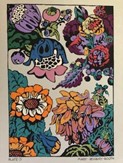From Japanese Katazome to French Pochoir
… and back again
Stenciling on rock walls is the oldest known art form, going back at least 35,000 years to the Aboriginal people of Australia. Highly developed in Japanese art dating back to at least the Nara period (710 to 794  CE), stenciling had reached a high level of sophistication by the time Japan opened to the West in the mid-19th century. This exhibit traces the trajectory of stenciling used in early 20th century applied arts: from 19th century Japanese Katazome, to 20th century Pochoir, and back again to 20th century Taisho. Stenciling (i.e., Pochoir) profoundly affected 20th century graphic arts. The American Bookbinders Museum is proud to present Stenciling in Book & Applied Arts: From Japanese Katazome to French Pochoir, an exhibit drawn from the collection of Alex Angell.
CE), stenciling had reached a high level of sophistication by the time Japan opened to the West in the mid-19th century. This exhibit traces the trajectory of stenciling used in early 20th century applied arts: from 19th century Japanese Katazome, to 20th century Pochoir, and back again to 20th century Taisho. Stenciling (i.e., Pochoir) profoundly affected 20th century graphic arts. The American Bookbinders Museum is proud to present Stenciling in Book & Applied Arts: From Japanese Katazome to French Pochoir, an exhibit drawn from the collection of Alex Angell.

Japanese Katazome

French Pochoiir
The exhibit opens with Japanese Katazome illustrations of the late 19th century, followed by examples of 20th century French, German and American Pochoir. The minimalism of the Japanese aesthetic, as opposed to the opulence typical of European art, profoundly influenced the Art Nouveau, Art Deco, and Arts and Crafts movements. Pochoir, the early 20th century French stenciling technique, put its visual “stamp” on 20th century design, retaining the influence of Katazome while developing its own style and aesthetic. Stenciling came full circle, with the work of Western Pochoir artists influencing Japanese Taisho art of the 1920s and 30s.

French Illustration

German Fashion Design

American Wallpaper
Experience the range and beauty of this extraordinary, subtle yet impactful, technique used for textiles, fashion, architectural interiors, and illustrations in books, magazines and bindings.

Stenciling Technique
See examples of stenciling’s layering technique and the tools of Pochoir artists.
Stenciling in Book and Applied Arts is open to the public at the American Bookbinders Museum from September 16 through December 30. Opening receptions is Saturday, September 16, for more details click here.


